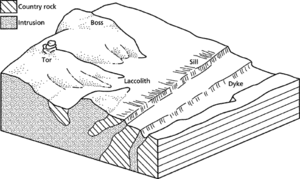A body of rock, usually igneous, that is emplaced within pre-existing rocks. Intrusions are classified according to their size, their shape, and their geometrical relationship to the enclosing rocks.
A mass of igneous rock which has forced its way, as magma, through pre-existing rocks, and then solidified below the surface of the ground; hence intrusive rock. See Jousset et al. (2003) J. Volc. & Geoth. Res. 125, 1–2.
Igneous intrusions are classified according to their shape and size: dykes are discordant, since they cut across the bedding or fabric of pre-existing rocks, sills are concordant, since they intrude between layers. Plutons are the largest intrusions, typically spheroidal, and ranging from stocks to batholiths.

Intrusion
- average sample number
- average tax rate
- average velocity
- averaging filter
- Averch-Johnson effect
- Averroës (1126–98)
- Averroës (c.1126–98)
- Averroës (or Abu Al-Walid Muhammad Ibn Ahmad Ibn Rushd)
- averted vision
- Avery, Oswald Theodore
- Avery, Oswald Theodore (1877–1955)
- Aves
- AVHRR
- aviation gasoline
- Avicebron
- Avicenna (980–1037)
- avidin
- avidity((in immunology))
- avidya
- avionics
- Avior
- Avirulence gene
- AVL tree
- AVN
- Avogadro, Amedeo (1776–1856)